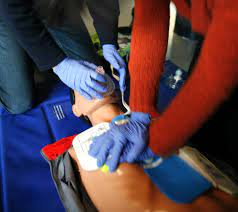Health Promotion
Task 2
Topic and significance
This campaign focuses on elderly falls. World Health Organization (WHO) defines fall as “an event that results in a person coming to rest inadvertently on the ground, floor or lower level” (2013). Many older adults fall, making them succumbs to severe injuries, many of which make them lose the ability to be self-independent and cause financial strains. On an annual basis, approximately 30-40% of the people aged over sixty-five years experience a fall at least once a year (Nicklett & Taylor, 2014).
Similarly, about 50% of those in nursing homes have experienced a decline in the within the last one year. Falls are recognized as the leading cause of accidental deaths in this age group, and in the UK, it is the 7th principal death cause. Studies indicate that 75% of the deaths among the elderly are associated with unintentional falls (Robertson & Gillespie, 2013).
Moreover, about 258,000 of the old people are admitted to hospitals annually as a result of hip fractures that result from falls (Rau et al., 2014). This hinders a high quality of life and causes immense medical costs. In 2013, direct medical expenses incurred from falls were as high as thirty billion (Robertson & Gillespie, 2013).
There is a projection that by 2020, over forty-four billion dollars will be dedicated towards these injuries (Robertson & Gillespie, 2013). These statistics make it apparent that falls among the elderly are a topic that needs to be campaigned on so that communities can take preventive measures. This would contribute to the lesser prevalence of the challenge.
Theories
Social learning theory
Social learning theory was developed by Albert Bandura (1977). Bandura explains that people learn in social environments by observing others and then imitates the behavior of others. In essence, this theory indicates that learning process is not just through reinforcement but also through influence from others (Cubas et al., 2015). There are four principles of social learning theory that have been developed namely attention, retention, reproduction and motivation. Inattention principle, learning will not occur if people are not focused.
Therefore, to obtain attention, it is important to design the training materials for patient fall prevention intervention differently so as to reinforce targeted group perceptions (Aliakbari, Parvin, Heidari, & Haghani, 2015). The targeted group includes nurses, elderly people representatives, unit nurse manager, registered nurses, nurse educators, orthopedic, physicians and community leaders.
The second principle is retention which states that people learn by internalizing the information stored in their memories. In this context, the training information will be designed in a manner that one can recall and respond appropriately (as taught). The third principle is reproduction which states that people actions are based on the information (behavior, knowledge or skills) previously learned (Aliakbari, Parvin, Heidari, & Haghani, 2015).
The training will be done in a way that it improves mental and physical rehearsal to ensure that the targeted populations reproduce the actions learned. Motivation is the last principle of this theory which states that most people’s actions are motivated, especially when they observe other people getting rewarded after for their actions. This motivation will help the people to do the same act (Cubas et al., 2015).
This theory works as a bridge between cognitive and behaviorist learning theories as it entails of motivation, memory, and attention. Therefore, when developing the campaign tool, one will focus on the novel as well as unique contexts that capture the targeted population attention in a manner that it stands out in their memory (Cubas et al., 2015).
The designing of the campaign tool will be done in a way that helps the targeted population to develop this self- efficacy individually through constructive feedback and confidence building. This concept in social learning theory is referred to as social modeling, and has been shown to be an effective method of education (which is the campaigns tool focus) (Aliakbari, Parvin, Heidari, & Haghani, 2015).
Stages of change model
The stages of change model also known as Transtheoretical Model was developed by James Prochaska and Carlo Diclemente in the early 1980s (Prochaska, 2013). According to this model, one should not assume that every person is ready for change because each individual has differing readiness to change. Therefore, when designing the campaigning tool, it is important to identify the target group position in the change process to match intervention to the people’s readiness to change. It is a bio psychosocial, integrative model for conceptualizing the intentional behavior change’s process (Lee, Park, & Min, 2015).
The stages of changes identified by this model included a) pre-contemplation, b) contemplation, c) preparation, d) action and e) maintenance. During the pre-contemplation, the target group is likely to be ignorant because they are not ready to adopt interventions foreseeable in the future (Prochaska, 2013). In this context, the campaigning tool is designed in a way that it encourages a re-evaluation of the existing behavior, explains, and supports self- exploration.
The contemplation stage is where the person is totally not ready for the change. The second stage is the consideration stage where people start becoming ambivalent to change. Therefore, the campaign tool is designed to ensure that it promotes the adoption of the suggested interventions (Lee, Park, & Min, 2015).
The third stage is the preparation stage which a stage where people are ready to change. In the action stage, people make specific overt modifications in their lifestyles (Prochaska, 2013). The campaigning tool is designed to enhance self-efficacy especially when dealing with obstacles and to help guard the frustrations. The last stage of this model is the maintenance stage which mainly focuses on the ongoing changes. In this case, maintenance will be reinforced through follow-up support (Lee, Park, & Min, 2015).
The rationale of the health promotion campaign based on stages of change model
This theory emphasizes on the role of other people during decision-making processes. The stages of change model apply in the elderly fall’s campaign. The first step was the presentation of negative impacts associated with old peoples’ falls. This is aimed at convincing the stakeholders about the urgency and need for change. Secondly, the theory helped one to expand people’s understanding of the social processes that influence the success of an implementation process (Prochaska, 2013).
Based on this model, some resistance is expected because most of the stakeholders already had a particular lifestyle and therefore making the changes needed to prevent falls would be met with some reluctance. The target group would move through the various stages as they try to weigh whether to change or not (Karlsson et al., 2013). The value of this approach is that it lays emphasis on professional communication where the caregiver’s providers can support one another. As such, offering them accurate information would be essential in promoting the change (Prochaska, 2013).
Effectiveness of the approved health promotion activity
The health promotion activity was sufficient because it explored the facilitators and barriers of elderly falls to develop strategic, evidence-based support aids in the reduction of the old falls (Prochaska, 2013). The training campaign on elderly falls preventive measure was useful because it was cost friendly (that is no huge costs are required to implement them) easy implementation process and it reached a large number of people at the same time (Balzer et al., 2012).
Own participation in the approved health promotion activity
The own primary involvement was through advocacy and mobilizing of the campaign to the stakeholders. The campaign took place at a community center hall for two days from 10.00Am to 3.00Pm. The participation involved creating rapport with the interested parties involved (nurses, elderly people representatives, unit nurse manager, registered nurses, nurse educators, orthopedic, physicians and community leaders).
This was critical in ensuring that they were open and at ease to discuss the factors that were contributing to elderly falls. This was vital as it made the target group and other involved stakeholders understand the importance of addressing the unique demands of older patients, which require patience as some of the seniors may have the hearing, language, and cognition problems. I also offered education on the strategic preventive measures against falls.
Whether the campaign was successful and had value and impact
The whole campaign was successful as detailed planning was done at every stage. The older adults and caregivers understood the reasons as to why falls had to be prevented. The campaign’s value and the impact were evident from the reduced prevalence of falls among the elderly, lesser hospitalizations, smaller costs dedicated towards falls, and an improved general wellbeing and health of the target group.
Strengths and weaknesses
The community members were able to learn a lot of insights about falls. The uptake of training on effective fall prevention measures was quite active; which increased awareness to the population that the aspect of fall is a healthcare concern (Gillespie et al., 2012). S
ome caregivers who previously did not have a caring attitude towards the elderly changed their attitudes and behavior after training, and most of the organizations were keen to implement some of the suggested change initiatives. However, a lot of time and resources had to be taken during the planning and implementation stages. This was quite strenuous. At the same time, reaching the seniors was a challenge due to their limited mobility.
Barriers and three recommendations on improving the campaign
The main obstacles were a lack of knowledge and motivation of healthcare providers, lack of change champions among the healthcare staff, language barriers, and lack of adequate resources. In future, the language barrier issues can be addressed by having a translator during any interaction with English non-speaking group. More efforts will be made so as to mobilize adequate resourced from stakeholders (Karlsson et al., 2013). This includes applying for funding from the government.
Lastly, leadership is an important aspect in implementing change in all organizations. The healthcare staff will be encouraged to attend leadership and management training so that they can understand better about their leadership roles and to offer a strong support and direction to the team members when implementing change. This will help the healthcare professionals to embrace their role as champions and facilitator in promoting and implementing change in their respective workstation (Karlsson et al., 2013).
Involvement in the campaign
The stakeholders involved in this campaign included; nurses, elderly people representatives, unit nurse manager, registered nurses, nurse educators, orthopedic, physicians and community leaders. Involving all the relevant stakeholders is very pivotal in promoting success. This is because they shape the direction of change in the early stages (Prochaska, 2013).
Involving the stakeholders will also ensure that all the project’s resources are available and provide insight about the probable reaction to project’s outcome or the necessary adjustments that must be made so as to win the community’s support. The benefits of all inclusive stakeholders involvement in this campaign is that it reduced distrust of the campaign’s outcome, increased commitment to the campaign processes and objectives and heightened the credibility of this campaign (Robertson &Gillespie, 2013).
Reflection
Collectively, this theory was useful in developing the multifaceted interventions that targeted change, promoted caregivers behavior, and ultimately improved the outcome of the campaign. An evaluation would be made after some duration after the changes have been embraced as a way of ensuring that the right things are being done appropriately (Balzer et al., 2012). Also, there are several elements identified after listening to other group’s presentation that we can adopt in the future. For instance, the use of pamphlets would have been effective as it would ensure that the information is widespread. Some groups used T-shirts to brand their campaign and to increase their coverage.
Conclusion
The campaign went well as the change model and theoretical frameworks used were correct for the topic. There are few aspects that many need to be refined according to our reviewer’s constructive criticism. However, participating in this activity was a good learning experience.
References
Aliakbari, F., Parvin, N., Heidari, M., & Haghani, F. (2015). Learning theories application in nursing education. Journal of Education and Health Promotion, 4, 2. http://doi.org/10.4103/2277-9531.151867
Balzer, K., Bremer, M., Schramm, S., Lühmann, D., &Raspe, H. (2012).Falls prevention for the elderly.GMS Health Technol Assess 8: Doc01.
Cubas, M. R., Costa, E. C. R. D., Malucelli, A., Nichiata, L. Y. I., & Enembreck, F. S. (2015). Components of social learning theory in a tool for teaching Nursing. Revista Brasileira de Enfermagem, 68(5), 906-912.
Gillespie, L. D., Robertson, M. C., Gillespie, W. J., Sherrington, C., Gates, S., et al. (2012).Interventions for preventing falls in older people living in the community. Cochrane Database Syst Rev.
Karlsson, M. K., Vonschewelov, T., Karlsson, C., Cöster, M., &Rosengen, B. E. (2013). Prevention of falls in the elderly: a review. Scand J Public Health 41: 442-454.
Lee, J. Y., Park, H. A., & Min, Y. H. (2015). Transtheoretical Model-based nursing intervention on lifestyle change: A review focused on intervention delivery methods. Asian nursing research, 9(2), 158-167.
Michael, Y. L., Lin, J. S., Whitlock, E. P., Gold, R., Fu, R. et al. (2010).Interventions to Prevent Falls in Older Adults: An Updated Systematic Review. Rockville (MD): Agency for Healthcare Research and Quality (US).
Robertson, M. C., &Gillespie, L. D. (2013). Fall prevention in community-dwelling older adults. JAMA 309: 1406-1407
Nicklett, E. J., & Taylor, R. J. (2014). Racial/ethnic predictors of falls among older adults: The Health and Retirement Study. Journal of Aging and Health, 26(6), 1060–1075. http://doi.org/10.1177/0898264314541698.
Rau, C.-S., Lin, T.-S., Wu, S.-C., Yang, J. C.-S., Hsu, S.-Y., Cho, T.-Y., & Hsieh, C.-H. (2014). Geriatric hospitalizations in fall-related injuries. Scandinavian Journal of Trauma, Resuscitation and Emergency Medicine, 22, 63. http://doi.org/10.1186/s13049-014-0063-1
Prochaska, J. O. (2013). Transtheoretical model of behavior change. In Encyclopedia of behavioral medicine (pp. 1997-2000). Springer New York.
Want help to write your Essay or Assignments? Click here









